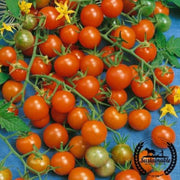Out Of Stock!
We will notify you when this product becomes available.
Tomato Seeds - Cherry - Sweetie (Organic)
65-70 Days to maturity (from transplant). Solanum lycoperscium. Organic Sweetie Tomato Seeds. Non-GMO, annual, organic, open-pollinated, heirloom, indeterminate cherry tomato. Suitable for growing in garden plots, raised beds, and greenhouses. Grows in clusters of 15-20 everbearing tomatoes weighing less than 1 oz. Perfect for home gardeners. Very sweet 1-1½ in. diameter globes with 12-14% sugar content. ~ 7,500 Seeds/ounce.





Download Free Vegetable Growing Guide PDF
Growing Organic Sweetie Tomatoes in the Vegetable Garden
To grow organic Sweetie tomatoes successfully, start by carefully considering the planting process. These sweet and flavorful tomatoes are best started indoors approximately 6-8 weeks before your last spring frost date, ensuring a long and productive growing season. Use a sterile and organic seed starting mix, such as Minute Soil Coco Coir, to promote good drainage and prevent diseases. Plant the Sweetie tomato seeds at a depth of about 1/4 inch in each cell or container. Once the seedlings are roughly 6-8 inches tall, they are ready for transplanting. When moving them to your organic garden, make sure to space the transplants about 18-36 inches apart to provide ample room for each plant to grow and spread, allowing for good airflow and reducing the risk of disease. Keep in mind that Sweetie tomatoes are indeterminate, meaning they continue to grow and produce fruit throughout the season, so proper spacing and support are crucial for their healthy development in your organic garden.
Regularly inspect your plants for common pests like aphids, hornworms, and whiteflies, as well as signs of diseases such as powdery mildew. Consider companion planting with basil, which not only enhances the flavor of your Sweetie tomatoes but also helps deter certain pests. Proper pruning is essential for maintaining good airflow, reducing disease risk, and ensuring healthy growth. Sweetie tomatoes are indeterminate, so they benefit from sturdy support structures like cages or stakes to keep them upright as they produce an abundance of sweet, cherry-sized fruits. Regular and consistent watering is essential, and mulching can help retain moisture while preventing soil splashback onto the foliage. Organic practices like using compost and organic granular fertilizers at planting and periodic applications of organic liquid soluble fertilizers like fish or kelp fertilizer can provide essential nutrients for robust growth. With these maintenance and growing tips, your organic Sweetie tomatoes will thrive and reward you with a bountiful harvest.
Harvesting Organic Sweetie Tomatoes
When it comes to harvesting Sweetie tomatoes, it's essential to know when they're at their peak ripeness. Sweetie tomatoes are classified as an indeterminate variety, which means they continue to produce fruit throughout the growing season, offering a more extended harvest period. To determine the optimal harvest time, look for fully ripe tomatoes that have reached their vibrant red color, typically when they are firm and easily separable from the stem with a gentle twist. Harvest the ripe tomatoes by gently but firmly grasping them and giving a slight twist; they should come off the vine without much effort. If tomatoes are not fully ripe but need to be picked due to adverse weather conditions, they can ripen indoors by being stored in a paper bag or box along with a banana, which releases ethylene gas, facilitating the ripening process. With their indeterminate nature, Sweetie tomatoes can be continually harvested as they ripen, ensuring a fresh and delicious supply of these sweet, cherry-sized delights throughout the growing season.
About Organic Sweetie Tomato Garden Seeds
The history of Sweetie tomatoes is rooted in the heritage of heirloom tomato varieties. These delightful cherry tomatoes have a rich history, cherished for their exceptional sweetness and unique flavor profile. While specific historical records may be limited, heirloom tomatoes like Sweetie have been passed down through generations, appreciated for their taste and the preservation of tradition. Their lineage reflects the enduring popularity of these sweet and flavorful tomatoes among home gardeners.
Sweetie tomatoes, as heirlooms, were not bred for a specific trait or growing climate but were cherished for their delectable flavor and uniqueness. Their adaptability makes them suitable for a wide range of growing climates, making them a popular choice among gardeners with diverse gardening conditions.
In addition to their flavor, Sweetie tomatoes have a firm texture, high sugar content, and produce abundant 1-1.5" fruits. They are ideal for fresh eating, salads, and snacking. While they are well-suited for container gardening, they may not be the best choice for hanging baskets due to their indeterminate growth habit and the larger size compared to some basket-friendly cherry tomato varieties. However, they thrive in containers with proper support and care, offering a flavorful addition to your home garden. These sweet and versatile tomatoes continue to captivate gardeners with their exceptional taste and adaptability in various growing environments.
Tips From Our Gardeners
"Consider mulching with crushed eggshells. Crushed eggshells are a natural source of calcium, which can help prevent the common tomato ailment known as blossom end rot. By placing a layer of crushed eggshells around the base of your Sweetie tomato plants, you can fortify the soil with calcium and reduce the risk of this issue. Additionally, eggshells act as a physical barrier, deterring certain pests like slugs and snails, providing a two-fold benefit for your organic garden. This eco-friendly and cost-effective solution not only fosters healthier plants but also reduces waste."
 |
- Chelsea Hafer, True Leaf Market Writer |
Other Resources
Organic Sweetie Tomato Seeds Per Package:
- 500 mg packet - Approximately 127 Seeds
- 0.25 oz - Approximately 1,875 Seeds
- 1 oz - Wholesale - Approximately 7,500 Seeds
- 4 oz - Wholesale - Approximately 30,000 Seeds
- 1 lb - Bulk Seeds - Approximately 120,000 Seeds
Non-GMO Organic Sweetie Tomato seeds are available for Fast Free Shipping on qualifying orders.
Basic Info
| Latin Name: | Solanum lycoperscium (previously Lycopersicon esculentum) |
| Tomato Type: | Cherry - Small fruited tomatoes that are often round or pear shaped. Typically the size of marbles but still smaller than a golf ball. |
| Organic Sweetie Tomato Color: | Red |
| Organic Sweetie Tomato Flavor: | Grown for additional sugar compared to other cherry tomatoes |
Growing Info
| Hardiness Zone: | 2, 3, 4, 5, 6, 7, 8, 9, 10, 11 Annual: Not intended to overwinter |
| Days to Maturity: | 65-70 |
| Days to Germination: | 7-10 |
| Seeding Depth: | 0.25 inch |
| Plant Spacing: | 18 to 36 inches |
| Row Spacing: | 36 inches |
| Plant Height: | 36 to 96 Inches |
| Growth Habit: | Indeterminate - Indeterminate tomatoes are vine-type plants that sprawl (requiring a cage or trellis to support them) and continue to grow throughout the season. Indeterminate tomato plants will continue to produce tomatoes for the rest of the season, so you can harvest continually. |
| Soil Preference: | Well-draining, loose (sandy loam), slightly acidic (6.2 to 6.8), and moisture retaining. Too much nitrogen in the soil may lead to more foliage production and less fruiting. Tomatoes like more phosphorus and potassium than other vegetables. |
| Temperature Preference: | Warmer (70-85 F) |
| Light Preference: | Full Sun |
Other
| Direct Sow: | No |
| Start Indoors: | Yes. Start Indoors 7-9 weeks before your last spring frost date. |
| Plant Width: | 18 to 36 inches |
| Growth Speed: | Early - Ready for harvest from about 60 to 69 days (or less, depending on variety) from transplant to harvest. Including time for indoor seed starts, this can range to about 130 days (or less depending on the variety) from sowing the seed to harvest. To have a tomato by the 4th of July, you would have to start seeds indoors from mid to late February and transplant by mid-April at the latest. |
| Germination Temperature: | 65-85 F |
| Pests and Diseases: | Common pests known to harm tomato plants, in general, include the tomato hornworm, cutworm, aphids, flea beetles, tomato fruit worms, and whiteflies. Also, watch for common diseases such as blossom end rot, fusarium wilt, powdery mildew, verticillium wilt, late blight, bacterial canker/spot, and tobacco mosaic virus. Most of these can be prevented by maintaining a regular watering schedule and avoiding overwatering. Regularly check your plants for pest damage throughout the season. For treating pest and disease problems, we recommend using an organic neem-based product. |
| Garden Size: | Greenhouse, Garden Plot, Raised Bed |
| Tomato Use: | Salads, fresh eating |














